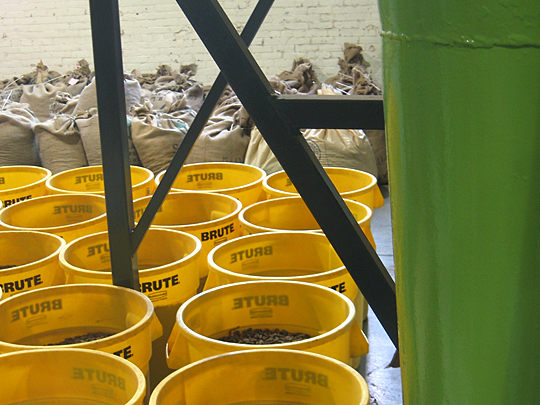I try to travel to Seattle at least once per year. There are at least a dozen or more friends of mine who ended up in Seattle for one reason or another, and it’s always a pleasure to see them. I’m always amazed by how quickly time passes–until I just did the math right now, I didn’t realize that I’ve known many of my Seattle friends for almost twenty years!
I flew to Seattle from Las Vegas for $80 on Virgin America. It’s unclear to me how Virgin America is making money. The flight was terrific, but it was also only half full. I had to switch planes in San Francisco, but I didn’t mind. I enjoy Virgin America’s flights.
I visited Seattle well before their terrible winter storms that shut down most of the city–if anything, it was unseasonably warm, pleasant, and dry. Seattle rarely has the torrential downpours of the northeast, but it frequently is covered by a gray, steady misty drizzle of rain that manages to float underneath any rain coat or umbrella. Which is why many Seattle residents never carry an umbrella.
One of the places I visited in Seattle was the Zig Zag Café. Several folks had recommended I go there, including Jim Meehan from PDT and Eryn Reece formerly with Bar Milano. The Zig Zag Café is located on the hill between the Public Market and Elliott Bay, just next door to a taqueria and downstairs from where the Spanish Table used to be. (Hey, if you know the shops near Pike Place Market, it’s a perfectly good description.) Jim specifically told me to be on the look out for Murray Stenson, an award-winning friendly and talented bartender. He wasn’t there the first evening I visited, so I spent some time chatting with one of the other bartenders who worked there and Kacy Fitch, one of the owners. It’s an elegant dimly lit bar with a tremendous selection of liquors, beers, and cocktails. There are many tables, but it’s a popular spot and fills up quickly. The staff is warm, friendly, and unpretentious.


Of course, I had to visit the Zig Zag Café a second time to see Murray. It was worth the second trip out there. Even though the place was packed, Murray took the time to say hello and recommend some other good restaurants in the area. I was walking around the waterfront area before going to Zig Zag, and I saw one of the most spectacular sunsets I had ever seen in Seattle. Friends of mine who were out agreed that it was a rare sight.



While I was in the Pike Place Market, I stopped by World Spice Merchants. World Spice Merchants has been featured on television shows like Alton Brown’s Good Eats. They have a very large selection of teas and spices; in addition to their retail and mail-order businesses, they also supply restaurants around the Seattle area. I feel that the folks there are more knowledgeable and passionate than the folks who work at a typical Penzey’s retail outfit. And that’s saying a lot: the folks at Penzey’s are smart and dedicated.

From a food perspective, no trip to Seattle would be complete without a trip to Salumi next to Pioneer Square. Salumi is a salumeria, a place where meats are cured and salamis are made. The store is divided into several parts: in the front of the store is a very small seating area, followed by a sandwich line and cashier, then a small seating area and a small kitchen. Beyond that there is another intimate dining room. Finally, the curing rooms are beyond the final door.

Salumi was opened by Armandino Batali after retiring from Boeing where he was an engineer. Last year, Armandino turned over the shop to his daughter, Gina Batali, and son-in-law, Brian D’Amato.
One of the best features of visiting Salumi is purchasing sandwiches from the counter. Most of the sandwiches are served on a nice white rich and not-overly tough sandwich roll with a variety of spreads and sauces. The tongue sandwich is one of the best sandwiches there: it’s served with slow-cooked soft onions and two spreads. (I believe one was a garlic spread, and one was a pesto spread.) I also had sliced fresh mozzarella. It was one of the best sandwiches I’ve ever had.

There’s more photos to come from my trip to Seattle.
Like this:
Like Loading...




















